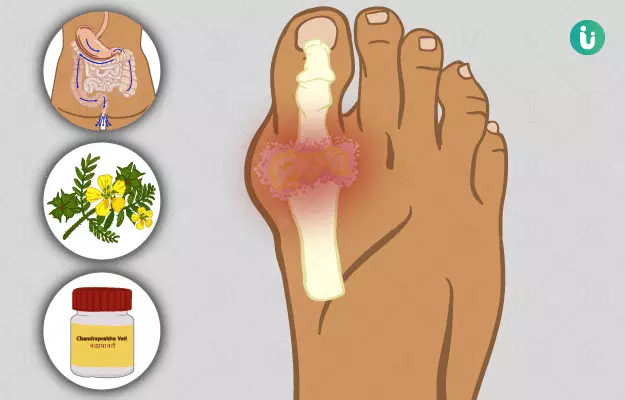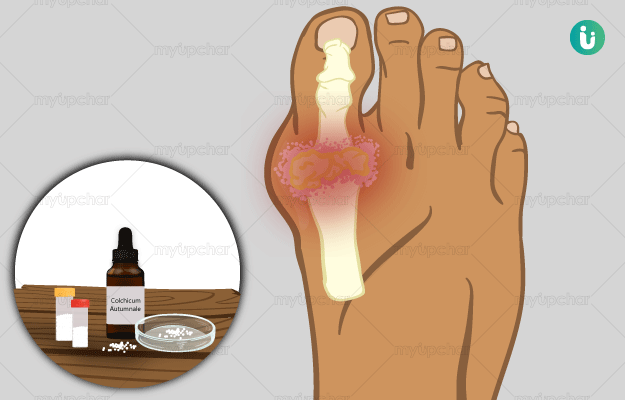Hyperuricaemia is a condition characterised by an excessive build-up of uric acid in the body. This uric acid saturates body fluids, leading to formation and accumulation of monosodium urate monohydrate crystals in different parts of the body, which manifests in the form of various diseases.
Hyperuricaemia occurs when uric acid forms faster than it can be eliminated from the body. Depending on the tissue involved, excess uric acid crystals may cause gout or urinary calculi. Gout is a type of arthritis that is characterised by sudden and severe attacks of pain, redness and tenderness of joints. It occurs due to accumulation of urate crystals in joints, tendons and the surrounding tissues. Urinary calculi are characterised by the accumulation of stones in the urinary system (obstructing the passage of urine) and pain during urination.
Ayurveda describes various treatments that can be effectively used in managing gout and kidney stones such as snehana (oleation), upanaha (fomentation), virechana (purgation), basti (enema), avagahana (sitz baths) and shastra karma (surgery). Herbs used in pacifying the aggravated vata and treating gout and kidney stones are- gokshura (small caltrops), bhumiamalaki (stonebreaker), pashanbheda (winter begonia) and punarnava (red hogweed). Ayurvedic medicines which are effective in treating hyperuricaemia include chandraprabha vati, gokshuradi guggulu and simhanada guggulu.
- Ayurvedic view of high uric acid
- Ayurvedic treatment for high uric acid in blood
- Ayurvedic herbs and medicines for high uric acid
- Dietary and lifestyle changes for hyperuricemia patient as per ayurveda
- How effective are ayurvedic medicines and treatments for high uric acid
- Side effects and risks of ayurvedic medicine and treatments for high uric acid
- Takeaway
Ayurvedic view of high uric acid
As per Ayurveda, two common conditions that occur due to high levels of uric acid are ashmari (stones) and vatarakta (gout).
Ashmari is primarily a condition of vata-kapha origin, though pitta dosha and shukra dhatu may also be involved in the formation of stones. Obstruction and injury in the urinary tract due to accumulation of stones may then affect ejaculation of semen in adults and lead to scrotal swelling and abdominal pain. Urinary stones are classified depending on the involvement of doshas, and the treatment methods vary accordingly.
Acharya Sushruta described different herbs that can be used in the form of ghrita (clarified butter), taila (oil), paneeya kshara (alkali preparation), etc. for the treatment of ashmari. These medications promote breaking, splitting, and scarification of the stone along with increasing the frequency of urination for easier expulsion of debris.
Vatarakta occurs by an obstruction of aggravated vata due to vitiated rakta. Vitiation in vata ultimately causes vitiation of entire rakta dhatu, which leads to symptoms such as pain, inflammation and swelling in joints. Vatarakta and is further classified as uttana and gambhira (uttana affects only the skin and muscles, whereas gambhira affects the deeper tissues).
Ayurvedic treatment for high uric acid in blood
- Snehana
- Snehana involves internal or external lubrication using oils infused with the properties of different herbs. Herbs for snehana procedure are chosen on the basis of individual medical condition. It helps in mobilising ama (toxins) and moving it to the digestive tract, from where it can be easily eliminated by panchakarma (five therapies).
- Snehapana (internal oleation) refers to the oral administration of medicated oils and is usually recommended for gastrointestinal conditions. Internal or external therapy is chosen based on the clinical condition and the physician's recommendation.
- Regardless of the mode of administration, these medicated oils help balance doshas and eliminate ama from the body, which, in turn, is effective in the treatment of high uric acid conditions like gout and kidney stones.
- Upanaha
- Upanaha is a type of swedana (sudation or sweat therapy), in which, a hot poultice consisting of appropriate herbs is applied to the affected parts of the body. It helps in reducing the aggravated doshas.
- Upanaha is the best therapy for diseases caused by vata dosha, which makes it a treatment of choice for gout.
- After application of poultice, the affected area is wrapped in warm woollen clothes overnight.
- Barley, wheat and kushtha (costus) are some commonly used herbs for upanaha.
- Virechana
- Virechana involves the induction of purgation for expelling aggravated doshas through the rectal route. It is commonly used to eliminate excess pitta, gives a feeling of lightness to the body and improves appetite.
- This procedure is effective in the management of disorders like gout, abdominal tumours, chronic fever, spleen and vaginal diseases, ulcers, and colon pain. It also improves the excretory process in individuals with suppressed urination.
- Basti
- It is an Ayurvedic enema therapy, which uses either a decoction-based enema or an oil-based enema.
- Basti of castor oil is mild and soothing and aids in clearing the excess doshas and accumulated ama form the colon.
- The primary step for managing kidney stones is treatment and prevention of constipation. Basti is the choice of panchakarma in individuals who can’t bear purgation therapy. This procedure lowers and eliminates the load of filtration on kidneys.
- Avoid excess physical and mental exertion post-basti. Also, avoid consuming food within one hour after this procedure.
- Sitz bath
- In this treatment, the individual is made to sit in a warm and shallow water bath. The water contains salt or herbs depending on the health of the individual.
- This procedure is useful for soothing and relieving pain and itching in genital and anal area. It is generally performed two to three times for about 10-20 minutes a day.
- The individual may feel lightheaded and dizzy after the sitz bath; therefore, it is suggested to hold on to support or take help from a family member or caregiver while getting up from the bath.
- Genital area should be gently patted and dried using a towel after the bath. Hands should be cleaned thoroughly at the end of this procedure.
- Shastra karma
- A surgical procedure is sometimes advised for hyperuricaemia to remove stones after pacifying the aggravated doshas.
- Following the removal of stones, bladder is irrigated with a herbal decoction.
- A paste of herbs like lodhra (lodh tree), manjishtha (Indian madder), prapaundrika (white Egyptian lotus) and madhuka (honey tree) is applied to the wound to promote recovery after the surgery.
- Basti and oral medicines are also given as post-surgical treatments.
Ayurvedic herbs and medicines for high uric acid
Ayurvedic herbs for high uric acid (hyperuricaemia)
- Gokshura
- Gokshura acts on the urinary, respiratory, reproductive and nervous systems and has aphrodisiac, pain-relieving, diuretic and rejuvenating properties. It also aids in clearing ama from the body.
- Gokshura is one of the most commonly used herbs in Ayurveda for the management of kidney problems and urinary stones. It increases the frequency of urination, breaks urinary stones and eliminates them through urethra. It can be used with punarnava for improving the overall health of kidney.
- Gokshura is also used for treating gout, back pain, cough, impotence, infertility and seminal debility.
- It can be used in the form of a decoction or powder.
- Bhumiamalaki
- Bhumiamalaki acts on the urinary, digestive and reproductive systems. It is useful in the management of inflammation, sores and swellings and, is thus, effective in the management of gout.
- This herb has been used for over 2000 years to treat kidney stones. Several chemical constituents of bhumiamalaki, e.g., alkaloids, lignans and flavonoids, are known to have litholytic properties, which enables them to break urinary stones. It also reduces the growth of stones and aggregation of stone forming crystals.
- Bhumiamalaki can be used in the form of an infusion, powder, pill, poultice and juice.
- Pashanbheda
- Pashanbheda acts on the urinary and female reproductive systems. It increases the frequency of urination, breaks urinary stones and has astringent (tissue constricting) properties.
- It is one of the best herbs for dissolving uric acid crystals and can be used in the management of gout and stones in the urinary system. It is also helpful in treating enlarged prostate, fever, vaginal diseases, cough and vata tumours.
- Pashanbheda can be taken in the form of a decoction, powder or paste.
- Punarnava
- Punarnava acts on the urinary, digestive, female reproductive, nervous and circulatory systems and has bitter, appetising, diuretic, emetic (induces vomiting) and rejuvenating properties.
- It is one of the primary herbs that are used for the treatment of kidney stones. It is also helpful in reducing inflammation, fever, cough and many other conditions. Punarnava is effective in the management of osteoarthritis and gout.
- It can be taken in the form of an infusion, juice, decoction, powder, oil, paste, sugar water or honey paste.
Ayurvedic medicines for high uric acid (hyperuricaemia)
- Chandraprabha vati
- Some of the ingredients of this formulation are chandraprabha (camphor tree), vacha (calamus), musta (nutgrass), vidanga (false black pepper), eranda (castor), shilajatu (asphaltum) and guggulu (Indian bdellium-tree).
- This formulation is taken with water after meals. It helps in relieving pain, inflammation and is also effective in reducing burning sensation during urination.
- Chandraprabha vati treats urinary calculi by disintegrating urinary stones. It is safe and effective to be used in children and elderly individuals.
Shilajit capsule and Shilajit Resin, developed by myUpchar Ayurveda, aids in urinary problem relief naturally. Its properties support kidney health and urinary function. Order now for a holistic approach to urinary well-being.
- Gokshuradi guggulu
- This Ayurvedic medicine consists of gokshura, guggulu, triphala (a combination of amalaki [Indian gooseberry], vibhitaki [belleric myrobalan], and haritaki [chebulic myrobalan]), trikatu (a combination of the three acrids – pippali [long pepper], shunthi [dried ginger] and maricha [black pepper]), and musta.
- It breaks urinary stones and helps in their easy elimination from the body.
- The guggulu in this formulation has a chemical constituent called guggulsterone, which relieves pain and inflammation.
- Simhanada guggulu
- Simhanada guggulu is prepared from vibhitaki, amalaki, haritaki, shuddha (pure) guggulu, shuddha gandhak (brimstone) and eranda moola (castor roots).
- This medicine stimulates the digestive power and promotes the digestion of ama. It also lowers the excessive production of kapha and clears obstructions from circulatory channels. This makes it an effective therapy for the management of conditions caused due to high uric acid such as gout.
Dietary and lifestyle changes for hyperuricemia patient as per ayurveda
Do’s
- Consume foods with vata-regulating properties such as yava (barley), mudga (green gram), puffed rice and rajma.
- Include fruits and vegetables like potatoes, pumpkins, bitter gourd, carrot, radish, banana, apricot, apple, plum and lemon in your daily meals.
- Include buttermilk, pineapple juice, lemon juice and coconut water in your diet.
Don’ts
- Do not eat heavy foods that are difficult to digest.
- Do not eat cold foods and drinks.
- Do not eat fatty foods, red meat, tomato, milk and milk products, yoghurt, and dried food items.
- Do not suppress natural urges like hunger, thirst, and the urge to evacuate the bladder and bowel.
- Avoid excessive physical work and exercise.
- Avoid daytime sleeping and excessive exposure to the sun.
How effective are ayurvedic medicines and treatments for high uric acid
A case study of a 47-year-old male with gout, who was experiencing symptoms like pain, swelling and inflammation in the right knee joint indicated the efficacy of Ayurvedic treatment in the management of gout symptoms. The individual was treated using Ayurvedic treatment methods like virechana and medicines such as yogaraja guggulu, punarnava, dashmoola (10 roots), kaishora guggulu, gandharva haritaki, chopchini (china root) and rasna (Indian camphorweed). Almost all the symptoms of gout were found to be relieved after 15 days of the treatment.
A clinical study, involving 40 participants, compared the effectiveness of basti with abhyanga and rakta mokshana in the treatment of high uric acid levels. All the participants were divided into two groups and were administered either of the treatment. Results of this study suggest that basti therapy is 25% more effective in improving gout symptoms and thus it can be used a primary line of treatment in gout.
Side effects and risks of ayurvedic medicine and treatments for high uric acid
Ayurvedic treatments and medicines are considered to be safe when taken under the supervision of an experienced doctor. However, improper use of these herbs may lead to certain side effects, depending on individual prakriti. for e.g.,
- Snehana is contraindicated in individuals with aggravated kapha
- Virechana is contraindicated in children, elderly, and weak individuals. It is not advisable for pregnant women either.
- Basti is contraindicated in pregnant and menstruating women and also in individuals with anal inflammation and diarrhoea.
- Gokshura should not be used in dehydrated individuals.
Takeaway
Hyperuricaemia occurs due to an inability of the body to eliminate uric acid. It leads to conditions such as gout and kidney stones. Both these conditions are characterised by debilitating pain that has a direct impact on everyday life. Conventional treatments, though effective, do not prevent the relapse of this condition.
Ayurvedic treatment comprises herbs and medicines that not only break kidney stones and relieve inflammation and pain in joints but also pacifying the elevated vata, which is responsible for causing these conditions thus preventing relapse.
Find Ayurvedic Doctor in cities
Doctors for Ayurvedic medicine, treatment and remedies for High Uric Acid

Dr. Ayush Bansal
Ayurveda
2 Years of Experience

Dr. Megha Sugandh
Ayurveda
6 Years of Experience

Dr. Nadeem
Ayurveda
3 Years of Experience

Dr.Ashok Pipaliya
Ayurveda
12 Years of Experience
References
- A Kopke Aa and OBW Greeffa. Hyperuricaemia and gout. Department of Pharmacology, University of Pretoria. South African Family Practice 2015; 57(1):6-12.
- Charaka. [Internet]. Institute of Panchkarma and Research. Gout.
- Ministry of Ayush. [Internet]. Government of India. Ayurvedic Standard Treatment Guidelines.
- Gandhidas Sonajirao Lavekar. A Practical Handbook of Panchkarma Procedures. Ministry of Health, Govt. of India.
- Kieley S, Dwivedi R, Monga M. Ayurvedic medicine and renal calculi.. J Endourol. 2008 Aug;22(8):1613-6. PMID: 18620498.
- Alternative & Integrative Medicine. [Internet]. OMICS International . The concept of Urolithiasis (Ashmari) in Ayurveda.
- Subhashree M. N. et al. Ayurvedic Management of Pediatric Urolithiasis (Mutrashmani): A Case Study. Int. J. Res. Ayurveda. Pharm. 8(1), Jan-Feb, 2017.
- : Ramteke R (2016). Case Report Open Access Management of Rheumatoid Arthritis through Ayurveda. J Tradi Med Clin Natur 5:189.
- Nishant Singh. Panchakarma: Cleaning and Rejuvenation Therapy for Curing the Diseases . Journal of Pharmacognosy and Phytochemistry. ISSN 2278- 4136. ZDB-Number: 2668735-5. IC Journal No: 8192.
- Swami Sadashiva Tirtha. The Ayurveda Encyclopedia. Sat Yuga Press, 2007. 657 pages.
- Lakshmi C. Mishra. Scientific Basis for Ayurvedic Therapies. C.R.C Press.
- Vaidya Bhagwan Dash and Acarya Manfred Junius. A handbook of ayurveda. pp 195-196 , 1987, Concept Publishing Company, New Delhi.
- Saint Luke's. [Internet]. Kansas City, Missouri, United States; Taking a Sitz Bath.
- International Research Journal of Pharmacy 4(3):85-89 · March 2013 with 941 Reads DOI: 10.7897/2230-8407.04314.
- Dr. K. V. Chakradhar. A Comparative Clinical Study on Renal Calculi – An Ayurvedic Perspective. IOSR Journal of Dental and Medical Sciences (JDMS) ISSN: 2279-0853. ISBN: 2279-0861.Volume 2, Issue 5 (Nov.- Dec. 2012), PP 21-32.
- Shweta A. Pandey, Nayan P. Joshi, and Dilip M. Pandya. Clinical efficacy of Shiva Guggulu and Simhanada Guggulu in Amavata (Rheumatoid Arthritis). Ayu. 2012 Apr-Jun; 33(2): 247–254. PMID: 23559798.
- Global Journal of Addiction & Rehabilitation Medicine. Ayurvedic Management of Vatarakta (gout) - A Case Report. Arcadia, California, United States.
- Ahalya Sharma. et al. Evaluation of the Efficacy of Siravyadha and Guduchi Sidhha Yoga Bastin in the Management of Vatarakta with special Reference to Gout. Int. J. Res. Ayurveda Pharm. 4(3), May-June 2013.













